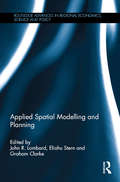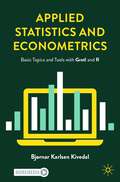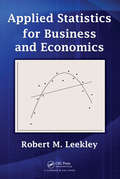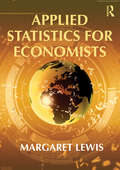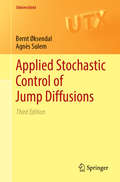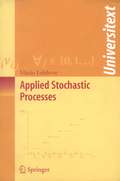- Table View
- List View
Applied Spatial Modelling and Planning (Routledge Advances in Regional Economics, Science and Policy)
by John R. Lombard, Eliahu Stern and Graham ClarkeThis book highlights the extraordinary range of areas to which geographical analysis and spatial modelling can bring lessons and insights. It shows how these techniques have been used to address ‘real world’ issues that are of concern to international organisations, public agencies and businesses, as illustrated by actual funded projects that geographers have developed collaboratively with end-users. Applied Spatial Modelling and Planning shows how much geographical research is policy relevant to a wide variety of agencies through the use of GIS and spatial modelling in applied geography. The book’s chapters contain a cross-section of innovative applications and approaches to problem solving within five major domains of the dynamics of economic space, housing and settlements, population movements and population ageing, health care, and the environment. Using a number of case studies on the use of GIS and spatial modelling, this book demonstrates the fact that much of what is done by quantitative geographers is not only relevant within academia, but also has use in policy work. This book will appeal to an international audience interested in cutting-edge spatial modelling to better understand the processes involved in solving real problems.
Applied Spatial Modelling and Planning (Routledge Advances in Regional Economics, Science and Policy)
by John R. Lombard Eliahu Stern Graham ClarkeThis book highlights the extraordinary range of areas to which geographical analysis and spatial modelling can bring lessons and insights. It shows how these techniques have been used to address ‘real world’ issues that are of concern to international organisations, public agencies and businesses, as illustrated by actual funded projects that geographers have developed collaboratively with end-users. Applied Spatial Modelling and Planning shows how much geographical research is policy relevant to a wide variety of agencies through the use of GIS and spatial modelling in applied geography. The book’s chapters contain a cross-section of innovative applications and approaches to problem solving within five major domains of the dynamics of economic space, housing and settlements, population movements and population ageing, health care, and the environment. Using a number of case studies on the use of GIS and spatial modelling, this book demonstrates the fact that much of what is done by quantitative geographers is not only relevant within academia, but also has use in policy work. This book will appeal to an international audience interested in cutting-edge spatial modelling to better understand the processes involved in solving real problems.
Applied Spatial Statistics and Econometrics: Data Analysis in R (Routledge Advanced Texts in Economics and Finance)
by Katarzyna KopczewskaThis textbook is a comprehensive introduction to applied spatial data analysis using R. Each chapter walks the reader through a different method, explaining how to interpret the results and what conclusions can be drawn. The author team showcases key topics, including unsupervised learning, causal inference, spatial weight matrices, spatial econometrics, heterogeneity and bootstrapping. It is accompanied by a suite of data and R code on Github to help readers practise techniques via replication and exercises. This text will be a valuable resource for advanced students of econometrics, spatial planning and regional science. It will also be suitable for researchers and data scientists working with spatial data.
Applied Spatial Statistics and Econometrics: Data Analysis in R (Routledge Advanced Texts in Economics and Finance)
by Katarzyna KopczewskaThis textbook is a comprehensive introduction to applied spatial data analysis using R. Each chapter walks the reader through a different method, explaining how to interpret the results and what conclusions can be drawn. The author team showcases key topics, including unsupervised learning, causal inference, spatial weight matrices, spatial econometrics, heterogeneity and bootstrapping. It is accompanied by a suite of data and R code on Github to help readers practise techniques via replication and exercises. This text will be a valuable resource for advanced students of econometrics, spatial planning and regional science. It will also be suitable for researchers and data scientists working with spatial data.
Applied Statistical Learning: With Case Studies in Stata (Statistics and Computing)
by Matthias SchonlauThis textbook provides an accessible overview of statistical learning methods and techniques, and includes case studies using the statistical software Stata. After introductory material on statistical learning concepts and practical aspects, each further chapter is devoted to a statistical learning algorithm or a group of related techniques. In particular, the book presents logistic regression, regularized linear models such as the Lasso, nearest neighbors, the Naive Bayes classifier, classification trees, random forests, boosting, support vector machines, feature engineering, neural networks, and stacking. It also explains how to construct n-gram variables from text data. Examples, conceptual exercises and exercises using software are featured throughout, together with case studies in Stata, mostly from the social sciences; true to the book’s goal to facilitate the use of modern methods of data science in the field. Although mainly intended for upper undergraduate and graduate students in the social sciences, given its applied nature, the book will equally appeal to readers from other disciplines, including the health sciences, statistics, engineering and computer science.
Applied Statistical Methods: ISGES 2020, Pune, India, January 2–4 (Springer Proceedings in Mathematics & Statistics #380)
by David D. Hanagal Raosaheb V. Latpate Girish ChandraThis book collects select contributions presented at the International Conference on Importance of Statistics in Global Emerging (ISGES 2020) held at the Department of Mathematics and Statistics, University of Pune, Maharashtra, India, from 2–4 January 2020. It discusses recent developments in several areas of statistics with applications of a wide range of key topics, including small area estimation techniques, Bayesian models for small areas, ranked set sampling, fuzzy supply chain, probabilistic supply chain models, dynamic Gaussian process models, grey relational analysis and multi-item inventory models, and more. The possible use of other models, including generalized Lindley shared frailty models, Benktander Gibrat risk model, decision-consistent randomization method for SMART designs and different reliability models are also discussed. This book includes detailed worked examples and case studies that illustrate the applications of recently developed statistical methods, making it a valuable resource for applied statisticians, students, research project leaders and practitioners from various marginal disciplines and interdisciplinary research.
Applied Statistics: Business and Management Research
by Andrew R. TimmingWritten for the non-mathematician and free of unexplained technical jargon, Applied Statistics: Business and Management Research provides a user-friendly introduction to the field of applied statistics and data analysis. Featuring step-by-step explanations of how to carry out successful quantitative research, and supported by examples from IBM® SPSS® Statistics, this textbook is an essential resource for students and researchers of business and management. A range of online resources for both students and lecturers, including a teaching guide, PowerPoint slides and datasets, are available via the companion website. Andrew R. Timming is Professor of Human Resource Management and Deputy Dean Research & Innovation in the School of Management at RMIT University, Australia.
Applied Statistics: Business and Management Research
by Andrew R. TimmingWritten for the non-mathematician and free of unexplained technical jargon, Applied Statistics: Business and Management Research provides a user-friendly introduction to the field of applied statistics and data analysis. Featuring step-by-step explanations of how to carry out successful quantitative research, and supported by examples from IBM® SPSS® Statistics, this textbook is an essential resource for students and researchers of business and management. A range of online resources for both students and lecturers, including a teaching guide, PowerPoint slides and datasets, are available via the companion website. Andrew R. Timming is Professor of Human Resource Management and Deputy Dean Research & Innovation in the School of Management at RMIT University, Australia.
Applied Statistics: Business and Management Research
by Andrew R. TimmingWritten for the non-mathematician and free of unexplained technical jargon, Applied Statistics: Business and Management Research provides a user-friendly introduction to the field of applied statistics and data analysis. Featuring step-by-step explanations of how to carry out successful quantitative research, and supported by examples from IBM® SPSS® Statistics, this textbook is an essential resource for students and researchers of business and management. A range of online resources for both students and lecturers, including a teaching guide, PowerPoint slides and datasets, are available via the companion website. Andrew R. Timming is Professor of Human Resource Management and Deputy Dean Research & Innovation in the School of Management at RMIT University, Australia.
Applied Statistics and Econometrics: Basic Topics and Tools with Gretl and R
by Bjørnar Karlsen KivedalThis accessible textbook introduces the foundations of applied econometrics and statistics for undergraduate students. It covers key topics in econometrics by using step-by-step examples in Gretl and R, providing a guide to using statistical software and the tools for econometric analysis in one self-contained resource. Taking a concise, non-technical approach, the book covers topics including simple regression and hypothesis testing, multiple regression with control variables and isolating effects, instrumental variables, dummy variables, non-linear effects, probability models, heteroskedasticity, time series analysis, and other applied statistical tools such as t-tests and chi squared tests. The book uses small data sets to easily facilitate students’ transition from manual statistical calculations to using and understanding statistical software, including step-by-step examples of regression analysis, as well as additional chapters to aid with econometric notation and mathematical prerequisites, and accompanying online exercises and data sets. This book will be a valuable resource for upper undergraduate students taking courses in introductory econometrics and statistics, as well as students in business administration and other fields of study in social sciences utilising quantitative methods. Graduate students may also benefit from the book.
Applied Statistics and Multivariate Data Analysis for Business and Economics: A Modern Approach Using SPSS, Stata, and Excel
by Thomas CleffThis textbook will familiarize students in economics and business, as well as practitioners, with the basic principles, techniques, and applications of applied statistics, statistical testing, and multivariate data analysis. Drawing on practical examples from the business world, it demonstrates the methods of univariate, bivariate, and multivariate statistical analysis. The textbook covers a range of topics, from data collection and scaling to the presentation and simple univariate analysis of quantitative data, while also providing advanced analytical procedures for assessing multivariate relationships. Accordingly, it addresses all topics typically covered in university courses on statistics and advanced applied data analysis. In addition, it does not limit itself to presenting applied methods, but also discusses the related use of Excel, SPSS, and Stata.
Applied Statistics for Business and Economics
by Robert M. LeekleyDesigned for a one-semester course, Applied Statistics for Business and Economics offers students in business and the social sciences an effective introduction to some of the most basic and powerful techniques available for understanding their world. Numerous interesting and important examples reflect real-life situations, stimulating students to t
Applied Statistics for Business and Management using Microsoft Excel
by Linda Herkenhoff John FogliApplied Business Statistics for Business and Management using Microsoft Excel is the first book to illustrate the capabilities of Microsoft Excel to teach applied statistics effectively. It is a step-by-step exercise-driven guide for students and practitioners who need to master Excel to solve practical statistical problems in industry. If understanding statistics isn’t your strongest suit, you are not especially mathematically-inclined, or if you are wary of computers, this is the right book for you. Excel, a widely available computer program for students and managers, is also an effective teaching and learning tool for quantitative analyses in statistics courses. Its powerful computational ability and graphical functions make learning statistics much easier than in years past. However, Applied Business Statistics for Business and Management capitalizes on these improvements by teaching students and practitioners how to apply Excel to statistical techniques necessary in their courses and workplace. Each chapter explains statistical formulas and directs the reader to use Excel commands to solve specific, easy-to-understand business problems. Practice problems are provided at the end of each chapter with their solutions.
Applied Statistics for Economics and Business
by Durmuş ÖzdemirThis textbook introduces readers to practical statistical issues by presenting them within the context of real-life economics and business situations. It presents the subject in a non-threatening manner, with an emphasis on concise, easily understandable explanations. It has been designed to be accessible and student-friendly and, as an added learning feature, provides all the relevant data required to complete the accompanying exercises and computing problems, which are presented at the end of each chapter. It also discusses index numbers and inequality indices in detail, since these are of particular importance to students and commonly omitted in textbooks. Throughout the text it is assumed that the student has no prior knowledge of statistics. It is aimed primarily at business and economics undergraduates, providing them with the basic statistical skills necessary for further study of their subject. However, students of other disciplines will also find it relevant.
Applied Statistics for Economists
by Margaret LewisThis book is an undergraduate text that introduces students to commonly-used statistical methods in economics. Using examples based on contemporary economic issues and readily-available data, it not only explains the mechanics of the various methods, it also guides students to connect statistical results to detailed economic interpretations. Because the goal is for students to be able to apply the statistical methods presented, online sources for economic data and directions for performing each task in Excel are also included.
Applied Statistics for Economists
by Margaret LewisThis book is an undergraduate text that introduces students to commonly-used statistical methods in economics. Using examples based on contemporary economic issues and readily-available data, it not only explains the mechanics of the various methods, it also guides students to connect statistical results to detailed economic interpretations. Because the goal is for students to be able to apply the statistical methods presented, online sources for economic data and directions for performing each task in Excel are also included.
Applied Statistics for Public Policy
by Brian P. Macfie Philip M. NufrioThis practical text provides students with the statistical tools needed to analyze data, and shows how statistics can be used as a tool in making informed, intelligent policy decisions. The authors' approach helps students learn what statistical measures mean and focus on interpreting results, as opposed to memorizing and applying dozens of statistical formulae. The book includes more than 500 end-of-chapter problems, solvable with the easy-to-use Excel spreadsheet application developed by the authors. This template allows students to enter numbers into the appropriate sheet, sit back, and analyze the data. This comprehensive, hands-on textbook requires only a background in high school algebra and has been thoroughly classroom-tested in both undergraduate and graduate level courses. No prior expertise with Excel is required. A disk with the Excel template and the data sets is included with the book, and solutions to the end-of-chapter problems will be provided on the M.E. Sharpe website.
Applied Statistics for Public Policy
by Brian P. Macfie Philip M. NufrioThis practical text provides students with the statistical tools needed to analyze data, and shows how statistics can be used as a tool in making informed, intelligent policy decisions. The authors' approach helps students learn what statistical measures mean and focus on interpreting results, as opposed to memorizing and applying dozens of statistical formulae. The book includes more than 500 end-of-chapter problems, solvable with the easy-to-use Excel spreadsheet application developed by the authors. This template allows students to enter numbers into the appropriate sheet, sit back, and analyze the data. This comprehensive, hands-on textbook requires only a background in high school algebra and has been thoroughly classroom-tested in both undergraduate and graduate level courses. No prior expertise with Excel is required. A disk with the Excel template and the data sets is included with the book, and solutions to the end-of-chapter problems will be provided on the M.E. Sharpe website.
Applied Statistics for Social and Management Sciences
by Abdul Quader MiahThis book addresses the application of statistical techniques and methods across a wide range of disciplines. While its main focus is on the application of statistical methods, theoretical aspects are also provided as fundamental background information. It offers a systematic interpretation of results often discovered in general descriptions of methods and techniques such as linear and non-linear regression. SPSS is also used in all the application aspects. The presentation of data in the form of tables and graphs throughout the book not only guides users, but also explains the statistical application and assists readers in interpreting important features. The analysis of statistical data is presented consistently throughout the text. Academic researchers, practitioners and other users who work with statistical data will benefit from reading Applied Statistics for Social and Management Sciences.
Applied Stochastic Control of Jump Diffusions (Universitext)
by Bernt Øksendal Agnès SulemHere is a rigorous introduction to the most important and useful solution methods of various types of stochastic control problems for jump diffusions and its applications. Discussion includes the dynamic programming method and the maximum principle method, and their relationship. The text emphasises real-world applications, primarily in finance. Results are illustrated by examples, with end-of-chapter exercises including complete solutions. The 2nd edition adds a chapter on optimal control of stochastic partial differential equations driven by Lévy processes, and a new section on optimal stopping with delayed information. Basic knowledge of stochastic analysis, measure theory and partial differential equations is assumed.
Applied Stochastic Control of Jump Diffusions (Universitext)
by Bernt Øksendal Agnès SulemHere is a rigorous introduction to the most important and useful solution methods of various types of stochastic control problems for jump diffusions and its applications. Discussion includes the dynamic programming method and the maximum principle method, and their relationship. The text emphasises real-world applications, primarily in finance. Results are illustrated by examples, with end-of-chapter exercises including complete solutions. The 2nd edition adds a chapter on optimal control of stochastic partial differential equations driven by Lévy processes, and a new section on optimal stopping with delayed information. Basic knowledge of stochastic analysis, measure theory and partial differential equations is assumed.
Applied Stochastic Control of Jump Diffusions (Universitext)
by Bernt Øksendal Agnès SulemHere is a rigorous introduction to the most important and useful solution methods of various types of stochastic control problems for jump diffusions and its applications. Discussion includes the dynamic programming method and the maximum principle method, and their relationship. The text emphasises real-world applications, primarily in finance. Results are illustrated by examples, with end-of-chapter exercises including complete solutions. The 2nd edition adds a chapter on optimal control of stochastic partial differential equations driven by Lévy processes, and a new section on optimal stopping with delayed information. Basic knowledge of stochastic analysis, measure theory and partial differential equations is assumed.
Applied Stochastic Models and Control for Finance and Insurance
by Charles S. TapieroApplied Stochastic Models and Control for Finance and Insurance presents at an introductory level some essential stochastic models applied in economics, finance and insurance. Markov chains, random walks, stochastic differential equations and other stochastic processes are used throughout the book and systematically applied to economic and financial applications. In addition, a dynamic programming framework is used to deal with some basic optimization problems. The book begins by introducing problems of economics, finance and insurance which involve time, uncertainty and risk. A number of cases are treated in detail, spanning risk management, volatility, memory, the time structure of preferences, interest rates and yields, etc. The second and third chapters provide an introduction to stochastic models and their application. Stochastic differential equations and stochastic calculus are presented in an intuitive manner, and numerous applications and exercises are used to facilitate their understanding and their use in Chapter 3. A number of other processes which are increasingly used in finance and insurance are introduced in Chapter 4. In the fifth chapter, ARCH and GARCH models are presented and their application to modeling volatility is emphasized. An outline of decision-making procedures is presented in Chapter 6. Furthermore, we also introduce the essentials of stochastic dynamic programming and control, and provide first steps for the student who seeks to apply these techniques. Finally, in Chapter 7, numerical techniques and approximations to stochastic processes are examined. This book can be used in business, economics, financial engineering and decision sciences schools for second year Master's students, as well as in a number of courses widely given in departments of statistics, systems and decision sciences.
Applied Stochastic Processes (Universitext)
by Mario LefebvreThis book uses a distinctly applied framework to present the most important topics in stochastic processes, including Gaussian and Markovian processes, Markov Chains, Poisson processes, Brownian motion and queueing theory. The book also examines in detail special diffusion processes, with implications for finance, various generalizations of Poisson processes, and renewal processes. It contains numerous examples and approximately 350 advanced problems that reinforce both concepts and applications. Entertaining mini-biographies of mathematicians give an enriching historical context. The book includes statistical tables and solutions to the even-numbered problems at the end.
Applied Stochastic Processes
by Ming LiaoApplied Stochastic Processes presents a concise, graduate-level treatment of the subject, emphasizing applications and practical computation. It also establishes the complete mathematical theory in an accessible way. After reviewing basic probability, the text covers Poisson processes, renewal processes, discrete- and continuous-time Markov chains,
